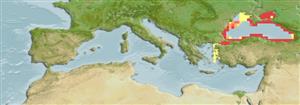Actinopterygii (peixes com raios nas barbatanas) >
Acipenseriformes (Sturgeons and paddlefishes) >
Acipenseridae (Sturgeons) > Acipenserinae
Etymology: Acipenser: Latin, acipenser = sturgeon, 1853 (Ref. 45335); gueldenstaedtii: Named for Johann Anton Güldenstädt (1745-1781).
Ambiente / Clima / Intervalo
Ecologia
; marinhas; Água doce; estuarina demersal; anádromos (Ref. 51243); intervalo de profundidade 2 - 100 m, usually 10 - 25 m. Temperate; 10°C - 20°C (Ref. 2059), preferred 11°C (Ref. 107945); 61°N - 35°N, 26°E - 54°E
Eurasia: Black Sea, Sea of Azov and Caspian Sea, entering all main rivers that empty into them (Don, Kuban, Danube, Dnieper (rare), Dniester) (Ref. 9953). Introduced throughout Europe. Considered critically endangered (Ref. 59043). International trade restricted (CITES II, since 1.4.98; CMS Appendix II).
Length at first maturity / Tamanho / Peso / Idade
Maturity: Lm ? range ? - ? cm
Max length : 236 cm TL macho/indeterminado; (Ref. 59043); common length : 145 cm TL macho/indeterminado; (Ref. 3561); Peso máx. publicado: 115.0 kg (Ref. 6866); Idade máx. registada: 46 anos (Ref. 3561)
Descrição suscinta
Morfologia | Morfometria
Espinhos dorsais (total): 0; Raios dorsais (total): 27-48; Raios anais : 16 - 35. Under the name A. g. colchicus. Lower lip not continuous, interrupted at center. Five rows of scutes: dorsal 7-19, lateral 24-44 on each side, ventral 6-13 on each side, with lines of smaller stellate bony plates between the dorsal and ventral rows. Color of back olivaceous grey, flanks lighter, and belly white.
Anadromous and freshwater populations exist. At the sea, it occurs in shallow coastal and estuarine zones. In freshwaters, it inhabits deep parts of large rivers with moderate to swift current (Ref. 59043). Found mainly near the shore over sand and mud. Usually solitary, but swarms when hibernating or during spawning migrations. Occasionally forms schools (Ref. 3241). Feeds on benthic molluscs, crustaceans and small fishes. Spawns on stone or gravel bottom in large and deep rivers with strong current, 1-1.5 m/s (Ref. 59043). Mainly propagated through artificial reproduction.
Under the name A. g. colchicus. Spawns in rivers. Natural spawning not extensive, maintained chiefly by artificial propagation. Enters rivers from April to June (a few in autumn).
Sokolov, L.I. and L.S. Berdicheskii, 1989. Acipenseridae. p. 150-153. In J. Holcík (ed.) The freshwater fishes of Europe. Vol. 1, Part II. General introduction to fishes Acipenseriformes. AULA-Verlag Wiesbaden. 469 p. (Ref. 9953)
Status na Lista Vermelha da IUCN (Ref. 115185)
Perigo para os humanos
Harmless
Uso pelos humanos
Pescarias: espécies comerciais; Aquacultura: espécies comerciais; Aquário: Aquários públicos
Mais informação
ReferênciasAquaculturaPerfil para aquaculturaEstirpesGenéticaFrequência alélicaHereditariedadeDoençasProcessamentoMass conversion
Ferramentas
Relatórios especiais
Baixar XML
Fontes da internet
